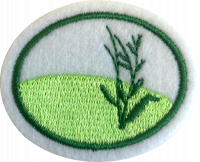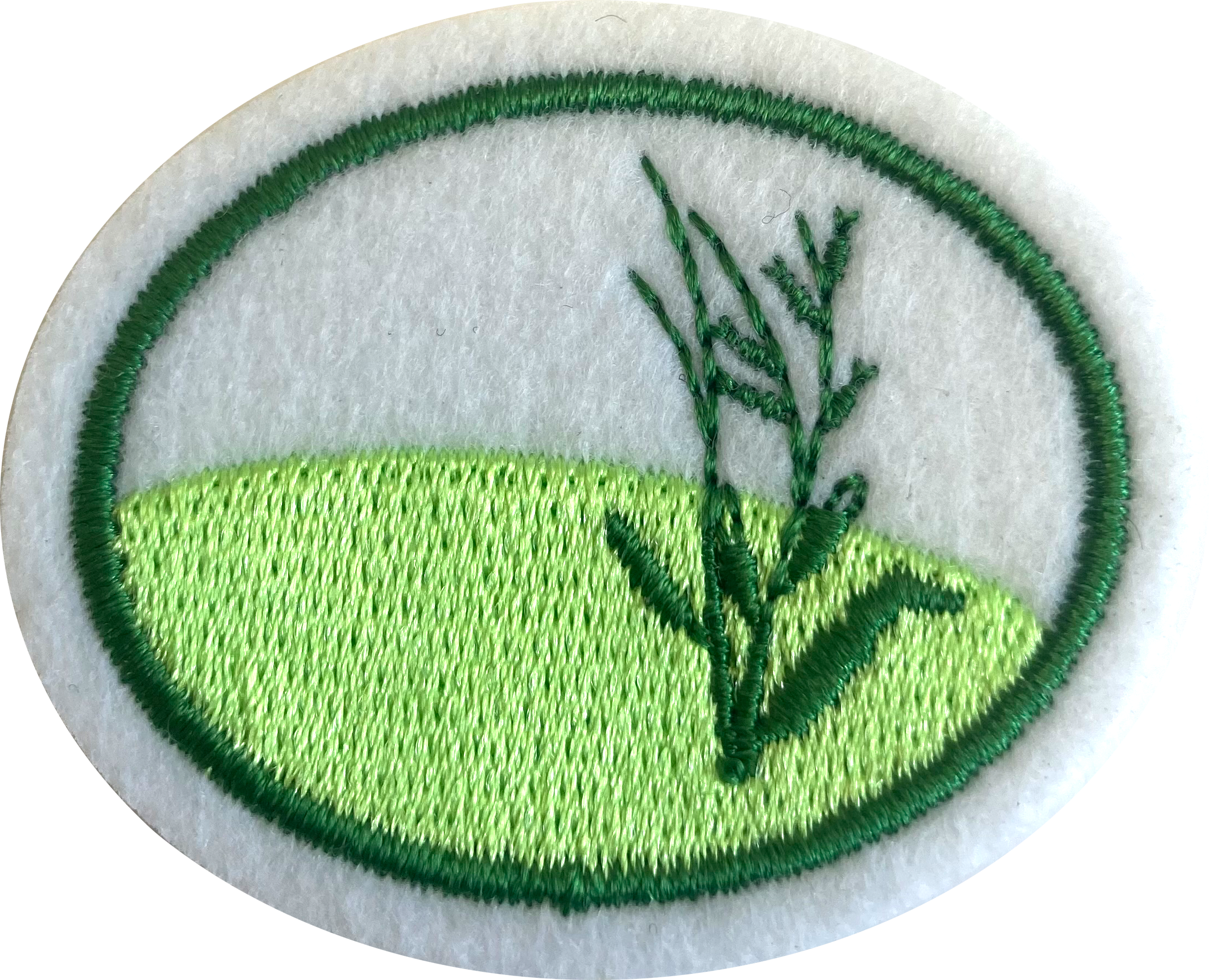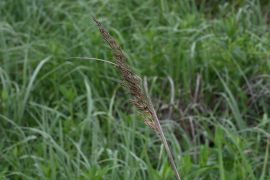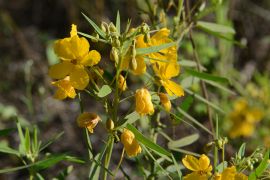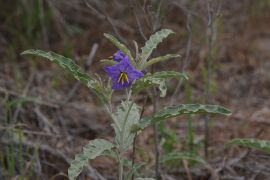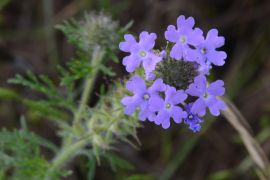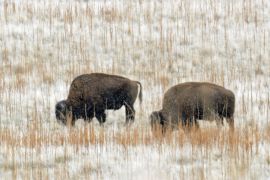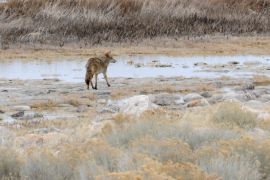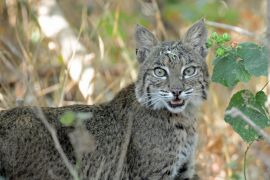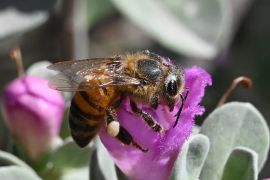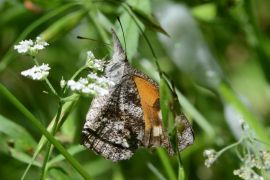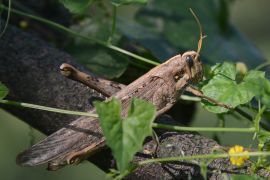Difference between revisions of "AY Honors/Temperate Grasslands/Answer Key"
m |
(Marked this version for translation) |
||
| (3 intermediate revisions by 2 users not shown) | |||
| Line 16: | Line 16: | ||
Grasslands can be found in temperate and tropical environments on all continents aside from Antarctica, usually as an intermediate zone between deserts and woodlands or forests. Large grasslands include the Shortgrass and Tallgrass prairies of North America, the steppes of Eurasia, the Puszta of Hungary, the Veldt of South Africa, and the Pampas of South America, as well as the tropical Savannas of Africa and India. | Grasslands can be found in temperate and tropical environments on all continents aside from Antarctica, usually as an intermediate zone between deserts and woodlands or forests. Large grasslands include the Shortgrass and Tallgrass prairies of North America, the steppes of Eurasia, the Puszta of Hungary, the Veldt of South Africa, and the Pampas of South America, as well as the tropical Savannas of Africa and India. | ||
| + | <!--T:59--> | ||
A couple of good maps of temperate grasslands can be found below, to get you started. Note that they are not exactly the same, as the definitions of different biomes not standardized, and there are many intermediate zones within and between different biomes. But the general locations of temperate grasslands can be explored from these and other maps. Once you discover their global distribution, focus down on your own country or local region, to discover grasslands you can explore yourself as you work on this honor. | A couple of good maps of temperate grasslands can be found below, to get you started. Note that they are not exactly the same, as the definitions of different biomes not standardized, and there are many intermediate zones within and between different biomes. But the general locations of temperate grasslands can be explored from these and other maps. Once you discover their global distribution, focus down on your own country or local region, to discover grasslands you can explore yourself as you work on this honor. | ||
| + | <!--T:60--> | ||
[https://www.iucn.org/sites/default/files/import/downloads/grasslandsnewsletterjan2010.pdf Temperate Grasslands Conservation Initiative] | [https://www.iucn.org/sites/default/files/import/downloads/grasslandsnewsletterjan2010.pdf Temperate Grasslands Conservation Initiative] | ||
| + | <!--T:61--> | ||
[https://earthobservatory.nasa.gov/biome/biograssland.php NASA Earth Observatory] | [https://earthobservatory.nasa.gov/biome/biograssland.php NASA Earth Observatory] | ||
| Line 52: | Line 55: | ||
There are several ways to describe different grasslands. | There are several ways to describe different grasslands. | ||
| + | <!--T:62--> | ||
Tropical grasslands include the vast African savannas, the smaller Indian savannas and Australian semi-arid grasslands. Like all grasslands, tropical grasslands are characterized by particular dominant grasses, but tropical grasslands also rarely or never experience frost, and often have distinct wet and dry seasons and nearly annual cycles of fire. | Tropical grasslands include the vast African savannas, the smaller Indian savannas and Australian semi-arid grasslands. Like all grasslands, tropical grasslands are characterized by particular dominant grasses, but tropical grasslands also rarely or never experience frost, and often have distinct wet and dry seasons and nearly annual cycles of fire. | ||
| + | <!--T:63--> | ||
Temperate grasslands include the prairies of North America, the short grass steppes of Eurasia, the humid pampas of South America, the South African veldt, and the Hungarian pustza. Temperate grasslands endure hot summers and cold winters, both of which can stress plant (and animal) life. They usually receive 10-30 inches of rain a year, and fires, while an important part of the temperate grassland biome, are not as pronounced as in the tropical grasslands. Temperate grasslands often have very rich soil due to centuries of decaying plant matter. | Temperate grasslands include the prairies of North America, the short grass steppes of Eurasia, the humid pampas of South America, the South African veldt, and the Hungarian pustza. Temperate grasslands endure hot summers and cold winters, both of which can stress plant (and animal) life. They usually receive 10-30 inches of rain a year, and fires, while an important part of the temperate grassland biome, are not as pronounced as in the tropical grasslands. Temperate grasslands often have very rich soil due to centuries of decaying plant matter. | ||
| + | <!--T:64--> | ||
In North America, there are the shortgrass prairies further west (with lower rainfall) and the tall grass prairies further east. Between the two are the mixed grass prairies, with the line between the three shifting depending upon weather and climate over the years. Shortgrass prairies are dominated by buffalograss (''Buchloe dactyloides'') and blue grama (''Bouteloua gracilis''), while tallgrass prairies are dominated by the "big four" - big bluestem (''Andropogon gerardii''), switchgrass (''Panicum virgatum''), indiangrass (''Sorghastrum nutans''), and little bluestem (''Shizachyrium scoparium''). | In North America, there are the shortgrass prairies further west (with lower rainfall) and the tall grass prairies further east. Between the two are the mixed grass prairies, with the line between the three shifting depending upon weather and climate over the years. Shortgrass prairies are dominated by buffalograss (''Buchloe dactyloides'') and blue grama (''Bouteloua gracilis''), while tallgrass prairies are dominated by the "big four" - big bluestem (''Andropogon gerardii''), switchgrass (''Panicum virgatum''), indiangrass (''Sorghastrum nutans''), and little bluestem (''Shizachyrium scoparium''). | ||
| + | <!--T:65--> | ||
Other ways of dividing grasslands into differing ecosystems focus on rainfall, ground cover, and the amount of taller shrubs and trees. For example, glades and barrens are rocky grasslands, with incomplete ground cover, on arid, poor soils. Sand barrens are grasslands in poor sandy soil. Meadows are grasslands near streams and ponds, with ample water, while bogs and fens are at times considered part of grasslands, despite the limited grass present. | Other ways of dividing grasslands into differing ecosystems focus on rainfall, ground cover, and the amount of taller shrubs and trees. For example, glades and barrens are rocky grasslands, with incomplete ground cover, on arid, poor soils. Sand barrens are grasslands in poor sandy soil. Meadows are grasslands near streams and ponds, with ample water, while bogs and fens are at times considered part of grasslands, despite the limited grass present. | ||
| Line 70: | Line 77: | ||
<!-- 2. Name three major taxonomic plant families can be found in a temperate grassland. Describe, photograph or draw five different species, and identify which of the families they fall under. --> | <!-- 2. Name three major taxonomic plant families can be found in a temperate grassland. Describe, photograph or draw five different species, and identify which of the families they fall under. --> | ||
| + | <!--T:66--> | ||
Poaceae (the grass family) - Wind-pollinated monocots that can grow from the base, rather than the tip, allowing continued growth after grazing or mowing. | Poaceae (the grass family) - Wind-pollinated monocots that can grow from the base, rather than the tip, allowing continued growth after grazing or mowing. | ||
| + | <!--T:67--> | ||
<gallery mode="packed"> | <gallery mode="packed"> | ||
Image:Buchloe dactyloides 2659.jpg|thumb|200px|Buffalograss (Buchloe dactyloides) | Image:Buchloe dactyloides 2659.jpg|thumb|200px|Buffalograss (Buchloe dactyloides) | ||
| Line 80: | Line 89: | ||
</gallery> | </gallery> | ||
| + | <!--T:68--> | ||
Apocynaceae (the dogbane family) - Plants in the dogbane family are characterized by flowers with five united petals and five united sepals. Within this large family are the milkweeds, common plants of southwestern grasslands, and critical plants for migrating Monarch butterflies. | Apocynaceae (the dogbane family) - Plants in the dogbane family are characterized by flowers with five united petals and five united sepals. Within this large family are the milkweeds, common plants of southwestern grasslands, and critical plants for migrating Monarch butterflies. | ||
| + | <!--T:69--> | ||
<gallery mode="packed"> | <gallery mode="packed"> | ||
Image:Asclepias asperula 7364.jpg|thumb|200px|Antelope Horns (Asclepias asperula) - Apocynaceae family | Image:Asclepias asperula 7364.jpg|thumb|200px|Antelope Horns (Asclepias asperula) - Apocynaceae family | ||
| Line 87: | Line 98: | ||
</gallery> | </gallery> | ||
| + | <!--T:70--> | ||
Asteraceae (the sunflower family) - Dicot plants with composite flowers made up of ray and disc flowers. | Asteraceae (the sunflower family) - Dicot plants with composite flowers made up of ray and disc flowers. | ||
| + | <!--T:71--> | ||
<gallery mode="packed"> | <gallery mode="packed"> | ||
Image:Gaillardia pulchella 9315.jpg|thumb|200px|Firewheel (Gaillardia pulchella) - Asteraceae family | Image:Gaillardia pulchella 9315.jpg|thumb|200px|Firewheel (Gaillardia pulchella) - Asteraceae family | ||
| Line 95: | Line 108: | ||
</gallery> | </gallery> | ||
| + | <!--T:72--> | ||
Fabaceae (the pea/legume family) - The flowers are often bilaterally symmetrical (zygomorphic), with uneven sized petals, though in some species flowers may be radially symmetrical. Leaves are often compound. | Fabaceae (the pea/legume family) - The flowers are often bilaterally symmetrical (zygomorphic), with uneven sized petals, though in some species flowers may be radially symmetrical. Leaves are often compound. | ||
| + | <!--T:73--> | ||
<gallery mode="packed"> | <gallery mode="packed"> | ||
Image:Lupinus texensis 6995.jpg|thumb|200px|Texas Bluebonnet (Lupinus texensis) - Fabaceae family | Image:Lupinus texensis 6995.jpg|thumb|200px|Texas Bluebonnet (Lupinus texensis) - Fabaceae family | ||
| Line 102: | Line 117: | ||
</gallery> | </gallery> | ||
| + | <!--T:74--> | ||
Lamiaceae (the mint family) - The Lamiaceae have squared (four-sided) stems, with flowers usually in whorls. | Lamiaceae (the mint family) - The Lamiaceae have squared (four-sided) stems, with flowers usually in whorls. | ||
| + | <!--T:75--> | ||
<gallery mode="packed"> | <gallery mode="packed"> | ||
Image:Monarda citriodora 3572.jpg|thumb|200px|Purple Horsemint (Monarda citriodora) - Lamiaceae family | Image:Monarda citriodora 3572.jpg|thumb|200px|Purple Horsemint (Monarda citriodora) - Lamiaceae family | ||
| Line 109: | Line 126: | ||
</gallery> | </gallery> | ||
| + | <!--T:76--> | ||
Solanaceae (the nightshade family) - The nightshades are characterized by flowers with five fused petals and a berry-like fruit. Nightshades are often toxic, though their edible members include tomatoes, potatoes, and eggplants. | Solanaceae (the nightshade family) - The nightshades are characterized by flowers with five fused petals and a berry-like fruit. Nightshades are often toxic, though their edible members include tomatoes, potatoes, and eggplants. | ||
| + | <!--T:77--> | ||
<gallery mode="packed"> | <gallery mode="packed"> | ||
Image:Solanum elaeagnifolium 6130.jpg|thumb|200px|Silver-Leaf Nightshade (Solanum elaeagnifolium) - Solanaceae family | Image:Solanum elaeagnifolium 6130.jpg|thumb|200px|Silver-Leaf Nightshade (Solanum elaeagnifolium) - Solanaceae family | ||
| Line 116: | Line 135: | ||
</gallery> | </gallery> | ||
| + | <!--T:78--> | ||
Verbenaceae (the vervain family) - Members of the vervain family frequently have squared stems (similar to their relative the Lamiaceae), with clusters or spikes of multiple small flowers. | Verbenaceae (the vervain family) - Members of the vervain family frequently have squared stems (similar to their relative the Lamiaceae), with clusters or spikes of multiple small flowers. | ||
| + | <!--T:79--> | ||
<gallery mode="packed"> | <gallery mode="packed"> | ||
Image:Verbena bipinnatifida 8321.jpg|thumb|200px|Prairie Verbena (Verbena bipinnatifida) - Verbenaceae family | Image:Verbena bipinnatifida 8321.jpg|thumb|200px|Prairie Verbena (Verbena bipinnatifida) - Verbenaceae family | ||
| Line 132: | Line 153: | ||
<!-- 3. Label a drawing of a grass including the following: blade, node, sheath, roots. --> | <!-- 3. Label a drawing of a grass including the following: blade, node, sheath, roots. --> | ||
| + | <!--T:80--> | ||
To acquire your model for drawing, gently pull a grass plant from the ground, holding near the base of the plant. You can gently shake off the dirt from the roots, or use water. Lay the grass plant down on a clean surface and sketch. Alternatively, you can hang the grass to dry, and use the dried specimen for your drawing model. Some useful grass terminology to keep in mind: in grasses, the vertical “stem” is called a CULM, the “leaf” is a BLADE, the lower part of the blade that wraps around the culm is the SHEATH. The joints in a grass culm are called NODES. A horizontal grass stem that runs above ground, giving rise to new plants at nodes, is called a STOLON, whereas a horizontal stem underground is a RHIZOME. The flowering structure of a grass is an INFLORESCENCE. Many of these features are important in distinguishing between grass species while in the field. | To acquire your model for drawing, gently pull a grass plant from the ground, holding near the base of the plant. You can gently shake off the dirt from the roots, or use water. Lay the grass plant down on a clean surface and sketch. Alternatively, you can hang the grass to dry, and use the dried specimen for your drawing model. Some useful grass terminology to keep in mind: in grasses, the vertical “stem” is called a CULM, the “leaf” is a BLADE, the lower part of the blade that wraps around the culm is the SHEATH. The joints in a grass culm are called NODES. A horizontal grass stem that runs above ground, giving rise to new plants at nodes, is called a STOLON, whereas a horizontal stem underground is a RHIZOME. The flowering structure of a grass is an INFLORESCENCE. Many of these features are important in distinguishing between grass species while in the field. | ||
| + | <!--T:81--> | ||
<gallery> | <gallery> | ||
Image:Anatomy 1247.jpg|thumb|The anatomy of a grass plant (Poa annua) | Image:Anatomy 1247.jpg|thumb|The anatomy of a grass plant (Poa annua) | ||
| Line 146: | Line 169: | ||
</noinclude> | </noinclude> | ||
<!-- 4. Temperate grasslands can be divided into what two subgroups? What are the differences? --> | <!-- 4. Temperate grasslands can be divided into what two subgroups? What are the differences? --> | ||
| − | Temperate grassland are divided into two broad groups based on the average height of the grass. Shortgrass prairies usually receive lower amounts of rainfall, and are dominated by grasses that rarely reach much | + | Temperate grassland are divided into two broad groups based on the average height of the grass. Shortgrass prairies usually receive lower amounts of rainfall, and are dominated by grasses that rarely reach much above 10 inches in height (ie Buffalograss and and Blue Grama). Tallgrass prairies receive more rainfall, with grasses that may reach 6 to 8 feet in height or more, including Big Bluestem, Little Bluestem, Yellow Indiangrass and .Switchgrass. In North America, the shortgrass prairies are usually further west than the tallgrass prairies, with a band of mixed grass prairies intermediate between the two. |
| − | Another bilateral categorization of temperate grasslands is based on the percent of shrub and | + | <!--T:82--> |
| + | Another bilateral categorization of temperate grasslands is based on the percent of shrub and tree cover - prairies have less than 10-20 percent tree cover, savannas have 20-40 percent tree cover. (This is an alternate use of the term savanna, which also often refers to tropical grasslands). A prairie can transition into savanna if there is insufficient grazing or fire, or an increase in available water. A savanna that does not have sufficient fire or grazing can develop into a woodland or forest. A major fire can so damage a forest that it reverts back to a prairie, and significant fire, drought, or new grazers can see a savanna turned back into a prairie. These processes are referred to as ecological succession, where one ecosystem changes into another due to altered circumstances or natural processes. | ||
<!--T:16--> | <!--T:16--> | ||
| Line 160: | Line 184: | ||
The main reasons trees do not grow in grasslands are low rainfall and physical stress, such as grazing and seasonal fires. Shrubs and trees will frequently encroach upon prairies when fires are suppressed or grazers are removed. | The main reasons trees do not grow in grasslands are low rainfall and physical stress, such as grazing and seasonal fires. Shrubs and trees will frequently encroach upon prairies when fires are suppressed or grazers are removed. | ||
| + | <!--T:83--> | ||
The relationship between Prairies, Savannas, and Woodlands, based on fire and grazing, can be seen in this piece of a display at the [https://www.wildflower.org/ Lady Bird Johnson Wildflower Center] in Austin, TX, which has several small research grassland plots testing different combinations of fires and mowing on grassland development. | The relationship between Prairies, Savannas, and Woodlands, based on fire and grazing, can be seen in this piece of a display at the [https://www.wildflower.org/ Lady Bird Johnson Wildflower Center] in Austin, TX, which has several small research grassland plots testing different combinations of fires and mowing on grassland development. | ||
| + | <!--T:84--> | ||
<gallery> | <gallery> | ||
Image:PrairieSavannaWoodland 8552.jpg|thumb|The relation between prairies, savannas, and woodlands, and the role of grazing and fire | Image:PrairieSavannaWoodland 8552.jpg|thumb|The relation between prairies, savannas, and woodlands, and the role of grazing and fire | ||
| Line 182: | Line 208: | ||
<!-- a. Plants --> | <!-- a. Plants --> | ||
| + | <!--T:85--> | ||
Plant adaptations to grasslands include low water needs, different methods of seed dispersals, quick early blooming (before the grasses get tall), and physical barriers to grazing, among others. Grasses store most of their reserve energy in their roots, allowing them to be protected from fire, as well as winter die-back. Many grasses grow from the base up, not from the tip out, so they can survive repeated grazing (or mowing). Grasses have numerous strategies to spread their seeds (from windblown to dropping nearby the parent), and many have phsical characteristics that protect them from predation, including fine hairs. Flowers like the Prairie Iris and Green Lily grow from bulbs that can lay dormant through winter, storing their energy below ground. The White Prickly Poppy , as its name implies, is covered in spines, protecting it from grazers. Texas Indian paintbrush is hemiparasitic, with its roots at times drawing nutrition from the grass roots in the prairie. Both the Horse Crippler and Prickly Pear are cacti, adapted to low water conditions common in southern prairies. And the Devil’s Claw, Spreading Hedge Parsley, and Common Cocklebur each have features on their seeds and seed pods that allow them to be carried by passing animals (or hikers). | Plant adaptations to grasslands include low water needs, different methods of seed dispersals, quick early blooming (before the grasses get tall), and physical barriers to grazing, among others. Grasses store most of their reserve energy in their roots, allowing them to be protected from fire, as well as winter die-back. Many grasses grow from the base up, not from the tip out, so they can survive repeated grazing (or mowing). Grasses have numerous strategies to spread their seeds (from windblown to dropping nearby the parent), and many have phsical characteristics that protect them from predation, including fine hairs. Flowers like the Prairie Iris and Green Lily grow from bulbs that can lay dormant through winter, storing their energy below ground. The White Prickly Poppy , as its name implies, is covered in spines, protecting it from grazers. Texas Indian paintbrush is hemiparasitic, with its roots at times drawing nutrition from the grass roots in the prairie. Both the Horse Crippler and Prickly Pear are cacti, adapted to low water conditions common in southern prairies. And the Devil’s Claw, Spreading Hedge Parsley, and Common Cocklebur each have features on their seeds and seed pods that allow them to be carried by passing animals (or hikers). | ||
| + | <!--T:86--> | ||
<gallery mode="packed"> | <gallery mode="packed"> | ||
Image:After Burn 1808.jpg|200px|thumb|Native bunch grasses recovering from a controlled fire | Image:After Burn 1808.jpg|200px|thumb|Native bunch grasses recovering from a controlled fire | ||
| Line 208: | Line 236: | ||
<!-- b. Birds --> | <!-- b. Birds --> | ||
| + | <!--T:87--> | ||
Birds are often adapted to the grasslands by the food they eat (seeds or insects), their nondescript coloration, or their nesting habits. Many birds also use the grasslands as their feeding and rest areas during long migrations. The Cattle Egret follows larger grazers in the grasslands, eating the insects they stir up. Sandhill Cranes feed in grasslands, and use them on their migration between the Arctic and Subtropics. The Loggerhead Shrike hunts insects, reptiles, and other small animals, at times skewering them on thorns to cache for later. Song and Savannah Sparrows have simple coloration that blends into the grasslands, while the painted bunting shows off bright colors, but prefers eating grass seeds. The Western Meadowlark is a ground nester, finding small depressions among the grass or brush, while the Dickcissel builds its nest close to the ground, weaving together grasses. The Scissor-Tailed Flycatcher hunts insects over the prairies, at times hovering in place, taking advantage of its long tail wings. | Birds are often adapted to the grasslands by the food they eat (seeds or insects), their nondescript coloration, or their nesting habits. Many birds also use the grasslands as their feeding and rest areas during long migrations. The Cattle Egret follows larger grazers in the grasslands, eating the insects they stir up. Sandhill Cranes feed in grasslands, and use them on their migration between the Arctic and Subtropics. The Loggerhead Shrike hunts insects, reptiles, and other small animals, at times skewering them on thorns to cache for later. Song and Savannah Sparrows have simple coloration that blends into the grasslands, while the painted bunting shows off bright colors, but prefers eating grass seeds. The Western Meadowlark is a ground nester, finding small depressions among the grass or brush, while the Dickcissel builds its nest close to the ground, weaving together grasses. The Scissor-Tailed Flycatcher hunts insects over the prairies, at times hovering in place, taking advantage of its long tail wings. | ||
| + | <!--T:88--> | ||
<gallery mode="packed"> | <gallery mode="packed"> | ||
Image:Bubulcus ibis 1442.jpg|200px|thumb|Cattle Egret (Bubulcus ibis) | Image:Bubulcus ibis 1442.jpg|200px|thumb|Cattle Egret (Bubulcus ibis) | ||
| Line 231: | Line 261: | ||
<!-- c. Mammals --> | <!-- c. Mammals --> | ||
| + | <!--T:89--> | ||
Mammal adaptations to grasslands include coloration, speed, feeding patterns, and adaptability. Pronghorn are the fasted land mammal in North America, able to outrun most any predator. The American Bison, North America’s largest land animal, once wandered the plains in the tens of millions, constantly shifting location to avoid overgrazing any one area. Mule Deer and White-Tailed Deer graze in the grasslands, able to leap and run quickly if predators are around. Rabbits and Jackrabbits also leap and turn quickly to avoid predators, both are able to conserve water, and both are colored to blend in to their environment. In more arid grasslands, the Jackrabbit’s long ears serve as radiators, letting off excess heat. Prairie Dogs dig extensive tunnels to hide, and primarily eat grass, drawing nearly all the water they need from the grasses, and thus not needing to be around streams or ponds. Coyotes have colors that blend in with the tall grasses, and are very adaptable in what they eat. Bobcats are normally found in woodlands and river bottoms, but also hunt in grasslands, seeking rabbits, rodents and other small mammals. | Mammal adaptations to grasslands include coloration, speed, feeding patterns, and adaptability. Pronghorn are the fasted land mammal in North America, able to outrun most any predator. The American Bison, North America’s largest land animal, once wandered the plains in the tens of millions, constantly shifting location to avoid overgrazing any one area. Mule Deer and White-Tailed Deer graze in the grasslands, able to leap and run quickly if predators are around. Rabbits and Jackrabbits also leap and turn quickly to avoid predators, both are able to conserve water, and both are colored to blend in to their environment. In more arid grasslands, the Jackrabbit’s long ears serve as radiators, letting off excess heat. Prairie Dogs dig extensive tunnels to hide, and primarily eat grass, drawing nearly all the water they need from the grasses, and thus not needing to be around streams or ponds. Coyotes have colors that blend in with the tall grasses, and are very adaptable in what they eat. Bobcats are normally found in woodlands and river bottoms, but also hunt in grasslands, seeking rabbits, rodents and other small mammals. | ||
| + | <!--T:90--> | ||
<gallery mode="packed"> | <gallery mode="packed"> | ||
Image:Antilocapra americana 5612.jpg|200px|thumb|Pronghorn (Antilocapra americana) | Image:Antilocapra americana 5612.jpg|200px|thumb|Pronghorn (Antilocapra americana) | ||
| Line 254: | Line 286: | ||
<!-- d. Insects --> | <!-- d. Insects --> | ||
| + | <!--T:91--> | ||
There are many interesting insect adaptations to live in grasslands, often related to what they eat or how they protect themselves. Dung Beetles eat and nest in animal dung, some rolling it into balls, others digging tunnels under dung piles, and still others just dwelling in the piles where they land. Leaf-Cutting Ants harvest grasses and plants, using them to grow fungus for food. Immature Froghoppers build protective “nests” of spit to protect themselves from predators. Honey Bees, Bumble Bees, and Carpenter Bees all feed off of the wildflowers in prairies, and have stingers as a defense mechanism. Numerous butterflies feed in the prairies. The Monarch caterpillars feed on milkweeds, leaving the butterflies toxic to predators (their bright coloration is a warning), the caterpillars of the Variegated Fritillary are one of the list picky, eating a wide variety of species, and the American Snout seems to detect when a major rainfall event may come after a drought, emerging in large numbers nearly simultaneously. Katydids and grasshoppers are able to leap (and fly), avoiding predators, while various Robber Flies use the prairies to hunt other insects. | There are many interesting insect adaptations to live in grasslands, often related to what they eat or how they protect themselves. Dung Beetles eat and nest in animal dung, some rolling it into balls, others digging tunnels under dung piles, and still others just dwelling in the piles where they land. Leaf-Cutting Ants harvest grasses and plants, using them to grow fungus for food. Immature Froghoppers build protective “nests” of spit to protect themselves from predators. Honey Bees, Bumble Bees, and Carpenter Bees all feed off of the wildflowers in prairies, and have stingers as a defense mechanism. Numerous butterflies feed in the prairies. The Monarch caterpillars feed on milkweeds, leaving the butterflies toxic to predators (their bright coloration is a warning), the caterpillars of the Variegated Fritillary are one of the list picky, eating a wide variety of species, and the American Snout seems to detect when a major rainfall event may come after a drought, emerging in large numbers nearly simultaneously. Katydids and grasshoppers are able to leap (and fly), avoiding predators, while various Robber Flies use the prairies to hunt other insects. | ||
| + | <!--T:92--> | ||
<gallery mode="packed"> | <gallery mode="packed"> | ||
Image:Canthon imitator 5149.jpg|200px|thumb|Dung Beetle (Canthon imitator) | Image:Canthon imitator 5149.jpg|200px|thumb|Dung Beetle (Canthon imitator) | ||
| Line 291: | Line 325: | ||
<!-- 8. Select a grassland and discover the following: --> | <!-- 8. Select a grassland and discover the following: --> | ||
| + | <!--T:93--> | ||
You can look at large grasslands, but it may be more applicable to focus on a particular grassland in your local area. There are several national, state, and even city parks that include native or restored grasslands, and some local parks or universities may have “pocket prairies” that can serve as a way to study a grassland in your own locale. Many of these have informative displays on site, or have small booklets available in hard copy or online providing additional information. It may also be useful to interview a ranger or park volunteer. There are several services that collect historical weather and climate data you can use to study your grassland. | You can look at large grasslands, but it may be more applicable to focus on a particular grassland in your local area. There are several national, state, and even city parks that include native or restored grasslands, and some local parks or universities may have “pocket prairies” that can serve as a way to study a grassland in your own locale. Many of these have informative displays on site, or have small booklets available in hard copy or online providing additional information. It may also be useful to interview a ranger or park volunteer. There are several services that collect historical weather and climate data you can use to study your grassland. | ||
Examples below look at two temperate grasslands, one a national grassland ([https://www.fs.usda.gov/detail/texas/about-forest/districts/?cid=fswdev3_008440 Caddo-LBJ National Grasslands]), the other a restored grassland in a local park ([https://www.austintexas.gov/department/commons-ford-ranch Commons Ford Ranch Metropolitan Park]). | Examples below look at two temperate grasslands, one a national grassland ([https://www.fs.usda.gov/detail/texas/about-forest/districts/?cid=fswdev3_008440 Caddo-LBJ National Grasslands]), the other a restored grassland in a local park ([https://www.austintexas.gov/department/commons-ford-ranch Commons Ford Ranch Metropolitan Park]). | ||
| Line 301: | Line 336: | ||
<!-- a. Size --> | <!-- a. Size --> | ||
| + | <!--T:94--> | ||
Caddo/LBJ - 38,186 acres, spread across three counties in north central Texas | Caddo/LBJ - 38,186 acres, spread across three counties in north central Texas | ||
| + | <!--T:95--> | ||
Commons Ford - 40 acres of restored prairie | Commons Ford - 40 acres of restored prairie | ||
| Line 314: | Line 351: | ||
<!-- b. Average temperature --> | <!-- b. Average temperature --> | ||
| + | <!--T:96--> | ||
Caddo/LBJ - 63.5 degrees mean annual temperature, 35-55 in the winter, 75-95 in the summer | Caddo/LBJ - 63.5 degrees mean annual temperature, 35-55 in the winter, 75-95 in the summer | ||
| + | <!--T:97--> | ||
Commons Ford - 69.4 degrees mean annual temperature, 38-66 in the winter, 72-98 in the summer | Commons Ford - 69.4 degrees mean annual temperature, 38-66 in the winter, 72-98 in the summer | ||
| Line 327: | Line 366: | ||
<!-- c. Average rainfall per year --> | <!-- c. Average rainfall per year --> | ||
| + | <!--T:98--> | ||
Caddo/LBJ - 35.4 in | Caddo/LBJ - 35.4 in | ||
| + | <!--T:99--> | ||
Commons Ford - 28 in | Commons Ford - 28 in | ||
| Line 340: | Line 381: | ||
<!-- d. Most common type of grass --> | <!-- d. Most common type of grass --> | ||
| + | <!--T:100--> | ||
Caddo/LBJ - Little Bluestem, Big Bluestem, Yellow Indiangrass, and Switchgrass (The big four prairie grasses) | Caddo/LBJ - Little Bluestem, Big Bluestem, Yellow Indiangrass, and Switchgrass (The big four prairie grasses) | ||
| + | <!--T:101--> | ||
Commons Ford - The big four, plus Sideoats Grama, Texas Grama, and Hairy Grama | Commons Ford - The big four, plus Sideoats Grama, Texas Grama, and Hairy Grama | ||
| Line 353: | Line 396: | ||
<!-- e. Common uses of the grassland by people --> | <!-- e. Common uses of the grassland by people --> | ||
| + | <!--T:102--> | ||
Caddo/LBJ - Recreation, Hunting, Grazing, Hiking, Camping | Caddo/LBJ - Recreation, Hunting, Grazing, Hiking, Camping | ||
| + | <!--T:103--> | ||
Commons Ford - Recreation, Bird Watching, Educational Outreach, Scientific Research | Commons Ford - Recreation, Bird Watching, Educational Outreach, Scientific Research | ||
| Line 368: | Line 413: | ||
Grasslands are important storehouses of biodiversity, clean and store water, clean air, sequester carbon, and serve as food for humans and animals, including key pollinators. Restoring and protecting grasslands can help provide clean water and air, secure soil from erosion, and ensure survival of pollinators and migratory birds. | Grasslands are important storehouses of biodiversity, clean and store water, clean air, sequester carbon, and serve as food for humans and animals, including key pollinators. Restoring and protecting grasslands can help provide clean water and air, secure soil from erosion, and ensure survival of pollinators and migratory birds. | ||
| + | <!--T:104--> | ||
Grasslands can be set aside as preserves, restored to native species, and managed through controlled burns and controlled access. You can take steps to protect and preserve smaller plots of grasslands by changing some areas in your yard or neighborhood to native grasses and wildflowers, reducing the use of yard chemicals, and learning more about and sharing with others the importance of grasslands. | Grasslands can be set aside as preserves, restored to native species, and managed through controlled burns and controlled access. You can take steps to protect and preserve smaller plots of grasslands by changing some areas in your yard or neighborhood to native grasses and wildflowers, reducing the use of yard chemicals, and learning more about and sharing with others the importance of grasslands. | ||
| Line 386: | Line 432: | ||
<!-- a. Visit a wild grassland and mark off a square meter of the grassland, identifying all the species of plants and animals that you find. Write, record or share your experience with your group. --> | <!-- a. Visit a wild grassland and mark off a square meter of the grassland, identifying all the species of plants and animals that you find. Write, record or share your experience with your group. --> | ||
| + | <!--T:105--> | ||
A one-meter study could be a Sabbath Afternoon activity, or perhaps on a club campout, check the same spot at different times during the day, to see the changes in what insects, spiders, and animals visit the spot. For inspiration, check out Chris Helzer’s [https://prairieecologist.com/square-meter-photography-project/ Square Meter Photography Project] | A one-meter study could be a Sabbath Afternoon activity, or perhaps on a club campout, check the same spot at different times during the day, to see the changes in what insects, spiders, and animals visit the spot. For inspiration, check out Chris Helzer’s [https://prairieecologist.com/square-meter-photography-project/ Square Meter Photography Project] | ||
| Line 397: | Line 444: | ||
<!-- b. Visit a zoo and draw/photograph animals that are typically found in a temperate grassland. --> | <!-- b. Visit a zoo and draw/photograph animals that are typically found in a temperate grassland. --> | ||
| + | <!--T:106--> | ||
Remember that the honor focuses on temperate grasslands, not the tropical grassland/savannah of Africa. However, you may want to use your zoo visit to study the animals of both temperate and tropical grasslands, and compare their similarities and differences to see how the different ecosystems highlight similar or alternative adaptations by animals. | Remember that the honor focuses on temperate grasslands, not the tropical grassland/savannah of Africa. However, you may want to use your zoo visit to study the animals of both temperate and tropical grasslands, and compare their similarities and differences to see how the different ecosystems highlight similar or alternative adaptations by animals. | ||
| + | |||
| + | <!--T:107--> | ||
| + | {{AY Honors/Zoo Visit}} | ||
<!--T:54--> | <!--T:54--> | ||
| Line 408: | Line 459: | ||
<!-- c. Watch at least 15 minutes of a live feed or video of a grassland and discuss what you learned. --> | <!-- c. Watch at least 15 minutes of a live feed or video of a grassland and discuss what you learned. --> | ||
| + | <!--T:108--> | ||
Live Feeds are a mixed bag, because animals are not necessarily predictable in when and where they may be, but a few that are relatively popular include: | Live Feeds are a mixed bag, because animals are not necessarily predictable in when and where they may be, but a few that are relatively popular include: | ||
| + | <!--T:109--> | ||
Canada’s [https://parks.canada.ca/pn-np/sk/grasslands Grasslands National Park] has two live webcams available: | Canada’s [https://parks.canada.ca/pn-np/sk/grasslands Grasslands National Park] has two live webcams available: | ||
[https://explore.org/livecams/bison/plains-bison-grasslands-national-park-cam-1 Bison Watering Hole] | [https://explore.org/livecams/bison/plains-bison-grasslands-national-park-cam-1 Bison Watering Hole] | ||
[https://explore.org/livecams/bison/plains-bison-grasslands-national-park-cam-2 Bison Calving Plains] | [https://explore.org/livecams/bison/plains-bison-grasslands-national-park-cam-2 Bison Calving Plains] | ||
| + | <!--T:110--> | ||
The Forest Service, in partnership with the Nature Conservancy and the National Forest Foundation has a live cam set up at Midewin National Tallgrass Prairie to [https://www.fs.usda.gov/detail/midewin/landmanagement/resourcemanagement/?cid=FSEPRD533280 watch an introduced bison herd]. | The Forest Service, in partnership with the Nature Conservancy and the National Forest Foundation has a live cam set up at Midewin National Tallgrass Prairie to [https://www.fs.usda.gov/detail/midewin/landmanagement/resourcemanagement/?cid=FSEPRD533280 watch an introduced bison herd]. | ||
| + | <!--T:111--> | ||
Devil’s Tower National Monument has a [https://www.nps.gov/media/webcam/view.htm?id=34CA6D33-B7F4-4D81-012FADCDA97D746E camera set up at the prairie dog town], though it only updates a still image every 30 seconds. | Devil’s Tower National Monument has a [https://www.nps.gov/media/webcam/view.htm?id=34CA6D33-B7F4-4D81-012FADCDA97D746E camera set up at the prairie dog town], though it only updates a still image every 30 seconds. | ||
| + | <!--T:112--> | ||
The Nature Conservancy’s Dunn Ranch Prairie also has a [https://www.nps.gov/media/webcam/view.htm?id=34CA6D33-B7F4-4D81-012FADCDA97D746E webcam, and archived video] of their live cam feed. | The Nature Conservancy’s Dunn Ranch Prairie also has a [https://www.nps.gov/media/webcam/view.htm?id=34CA6D33-B7F4-4D81-012FADCDA97D746E webcam, and archived video] of their live cam feed. | ||
| Line 445: | Line 501: | ||
<noinclude><translate></noinclude> | <noinclude><translate></noinclude> | ||
==References== <!--T:49--> | ==References== <!--T:49--> | ||
| + | |||
| + | <!--T:113--> | ||
| + | '''General Information about Grasslands''' | ||
| + | *Brown, L. (1988). Grasslands. Random House. (National Audubon Society Nature Guides) | ||
| + | *[https://education.nationalgeographic.org/resource/grasslands-explained/ Grasslands Explained] (National Geographic Society) | ||
| + | *[https://education.nationalgeographic.org/resource/grassland-biome/ Grassland Biome] (National Geographic Society) | ||
| + | *[https://earthobservatory.nasa.gov/biome/biograssland.php Grassland] (NASA Earth Observatory) | ||
| + | *[https://ucmp.berkeley.edu/exhibits/biomes/grasslands.php The Grassland Biome] (UC Museum of Paleontology) | ||
| + | *[https://www.tshaonline.org/handbook/entries/grasslands Grasslands] (Texas State Historical Association) | ||
| + | *[https://mdc.mo.gov/discover-nature/habitats/grasslands-prairies-savannas Grasslands, Prairies, and Savannas] (Missouri Department of Conservation) | ||
| + | *[https://www.segrasslands.org/recognize-grasslands Where to find and how to recognize grasslands] (Southeastern Grasslands Institute) | ||
| + | *[https://dnr.illinois.gov/content/dam/soi/en/web/dnr/education/documents/onlinewoodlands-7-.pdf Savannas] (Illinois Department of Natural Resources) | ||
| + | *[https://bg.copernicus.org/articles/12/1833/2015/bg-12-1833-2015.pdf Forests, savannas, and grasslands]: bridging the knowledge gap between ecology and Dynamic Global Vegetation Models (In Biogeosciences) | ||
| + | *[https://www.fs.usda.gov/Internet/FSE_DOCUMENTS/stelprdb5439005.pdf National Grasslands Interpretive Master Plan] (USDA, US Forest Service) | ||
| + | *[https://www.worldatlas.com/articles/the-largest-national-grasslands-in-the-united-states.html Largest Grasslands in the United States] (World Atlas) | ||
| + | *[https://www.usgs.gov/programs/land-management-research-program/science/ecosystems-we-study-grasslands Grassland Research] (USGS) | ||
| + | *[https://www.arcgis.com/apps/MapSeries/index.html?appid=d6f7c2f5513d42439daec437358866cd National Grasslands Story Map] | ||
| + | *[https://php.radford.edu/~swoodwar/biomes/?page_id=173 Temperate Grasslands] (Radford University) | ||
| + | *[https://www.dnr.state.mn.us/biomes/prairie.html Prairie Grassland Biome] (Minnesota Department of Natural Resources) | ||
| + | *[https://www.nps.gov/articles/series.htm?id=BD0B060D-B473-EAE5-C84D84326975AB3E Grasslands of the American Southwest] (National Park Service) | ||
| + | *[https://www.fs.usda.gov/managing-land/national-forests-grasslands/national-grasslands National Grasslands] (US Forest Service) | ||
| + | *[https://wrangle.org/ecotype/north-american-short-grass-prairie North American Shortgrass Prairies] (World Rangeland Learning Experience) | ||
| + | *[https://wrangle.org/ecotype/north-american-tall-grass-prairie North American Tallgrass Prairies] (World Rangeland Learning Experience) | ||
| + | *[https://www.nps.gov/tapr/learn/nature/a-complex-prairie-ecosystem.htm A Complex Prairie Ecosystem] (National Park Service) | ||
| + | *[https://keep.konza.k-state.edu/prairieecology/TallgrassPrairieEcology.pdf The Tallgrass Prairie] (Jill Haukos, Kansas State University) | ||
| + | *[https://www.hww.ca/en/wild-spaces/grasslands.html Grasslands] (Hinterland Who’s Who, Canada) | ||
| + | |||
| + | <!--T:114--> | ||
| + | '''Grassland Vegetation and Animals''' | ||
| + | *[https://tpwd.texas.gov/publications/pwdpubs/pwd_bn_w7000_0120/grassland/ Vegetation Types of Texas Grasslands] (Texas Parks and Wildlife) | ||
| + | *[https://sustainability.utexas.edu/prairie-plants-bushes-wildflowers Prairie Plants, Bushes & Wildflowers] (UT Austin) | ||
| + | *[https://plttexas.org/uploadedFiles/Websites/PLT_Texas/Content/PLT%20Activity%2088%20Blackland%20Prairies.pdf Blackland Prairie Animals] (PLT Texas) | ||
| + | *[http://ntmn.org/docs/guides/20150511-FIELD_GUIDE_Final.pdf Common Species of the Blackland Prairie] (TXMN, TPWD, TAMU) | ||
| + | *[https://forages.oregonstate.edu/regrowth/how-does-grass-grow/grass-types/short-and-tall-grasses Short and Tall Grasses of the Prairie] (Oregon State University) | ||
| + | *[https://www.fws.gov/species/attwaters-greater-prairie-chicken-tympanuchus-cupido-attwateri Attwater's Greater Prairie Chicken] (U.S. Fish and Wildlife Service) | ||
| + | *[https://tpwd.texas.gov/huntwild/wild/species/prong/ Pronghorn] (Texas Parks and Wildlife) | ||
| + | *[http://npshistory.com/brochures/tapr/wildflowers.pdf Common Wildflowers at Tallgrass Prairie National Preserve] (National Park Service) | ||
| + | |||
| + | <!--T:115--> | ||
| + | '''About Grasses''' | ||
| + | *[https://forages.oregonstate.edu/regrowth/how-does-grass-grow How Does Grass Grow] (Oregon State University) | ||
| + | *[https://forages.oregonstate.edu/regrowth/how-does-grass-grow/grass-types/short-and-tall-grasses Short and Tall Grasses] (Oregon State University) | ||
| + | *[https://forages.oregonstate.edu/regrowth/how-does-grass-grow/grass-structures/mechanisms-growth Mechanisms of Grass Growth] (Oregon State University) | ||
| + | *[https://open.lib.umn.edu/nativegrasses/chapter/1-1-parts-of-the-plant/ Parts of a Grass Plant] (University of Minnesota) | ||
| + | *[https://passel2.unl.edu/view/lesson/b724cc65392a Perennial Grass Growth and Development] (University of Nebraska Lincoln) | ||
| + | *[https://www.montana.edu/extension/invasiveplants/documents/publications/extension_publications/Grass%20identification%20basics_mt201402AG.pdf Grass Identification Basics] (Montana State University) | ||
| + | *[https://gardens.duke.edu/sites/default/files/Meet%20a%20Plant_Grass.pdf Meet a Plant: Grass] (Duke Gardens) | ||
| + | *[https://naturalhistory.si.edu/research/botany/research/grass-research Grass Research] (Smithsonian NMNH) | ||
| + | *[https://www.jimrichardsonphotography.com/index/G00002LvaeP7vBbM Pictures of Prairie Grass Roots] (Jim Richardson, National Geographic Photographer) | ||
| + | *[https://www.nps.gov/articles/000/flint-hills-tallgrasses.htm Grass Roots] (Tallgrass prairie National Preserve) | ||
| + | *[https://www.nps.gov/home/learn/nature/grasses.htm Grasses] (National Park Service) | ||
| + | *[https://counties.agrilife.org/kerr/files/2011/09/grass-growth-and-development_3.pdf Grass Growth and Development] (Texas A&M University) | ||
| + | |||
| + | <!--T:116--> | ||
| + | '''Conservation and Restoration''' | ||
| + | *[https://www.llela.org/visit/habitats/prairie-restoration Prairie Restoration] (Lewisville Lake Environmental Learning Area) | ||
| + | *[https://www.wildflower.org/project/prescribed-fire Prescribed Fire Research] (Lady Bird Johnson Wildflower Center) | ||
| + | *[https://www.youtube.com/watch?v=cu1dO3iJ9V4 Prescribed Fire video] (Lady Bird Johnson Wildflower Center) | ||
| + | *[https://www.nps.gov/tapr/learn/nature/fire-and-grazing-in-the-prairie.htm Fire and Grazing in the Prairie] (National Park Service) | ||
| + | *[https://travisaudubon.org/home/wp-content/uploads/2021/04/CommonsFordHistory_2019.pdf Commons Ford Prairie Restoration] (Travis Audubon) | ||
| + | *[https://www.sciencedirect.com/science/article/pii/S0264837717310372 Protecting our Prairies]: Research and policy actions for conserving America’s grasslands (in Land Use Policy) | ||
| + | *[https://prairieecologist.com/2011/06/05/the-myth-of-self-sustaining-prairies/ The Myth of the Self Sustaining Prairie] (Prairie Ecologist) | ||
| + | *[https://www.iucn.org/sites/default/files/import/downloads/grasslandsnewsletterjan2010.pdf Temperate Grasslands Conservation Initiative] | ||
| + | |||
| + | |||
<!--T:50--> | <!--T:50--> | ||
<noinclude></translate></noinclude> | <noinclude></translate></noinclude> | ||
{{CloseHonorPage}} | {{CloseHonorPage}} | ||
Latest revision as of 14:11, 28 June 2023
Skill Level
1
Year
2023
Version
03.12.2025
Approval authority
North American Division
1
As the name implies, a grassland is a terrestrial biome where grasses (poaceae) are the dominant vegetation. While there is no agreed upon measurement, grasslands generally have less than 10-40% tree and shrub cover. Some definitions consider a grassland with less than 10-20% tree/shrub cover a prairie, while those with 20-40% tree/shrub cover would be a savanna. Grasslands are also often characterized by relatively low rainfall and seasonal fires.
1a
Grasslands can be found in temperate and tropical environments on all continents aside from Antarctica, usually as an intermediate zone between deserts and woodlands or forests. Large grasslands include the Shortgrass and Tallgrass prairies of North America, the steppes of Eurasia, the Puszta of Hungary, the Veldt of South Africa, and the Pampas of South America, as well as the tropical Savannas of Africa and India.
A couple of good maps of temperate grasslands can be found below, to get you started. Note that they are not exactly the same, as the definitions of different biomes not standardized, and there are many intermediate zones within and between different biomes. But the general locations of temperate grasslands can be explored from these and other maps. Once you discover their global distribution, focus down on your own country or local region, to discover grasslands you can explore yourself as you work on this honor.
Temperate Grasslands Conservation Initiative
1b
A grassland needs sufficient water for the grasses and small plants to grow, but not enough water to support larger vegetation like shrubs and trees. Grasslands also frequently need either regular grazing or cyclical fires to suppress the growth of larger shrubs and plants.
1c
Grasslands are areas of high biodiversity, capture and store large amounts of carbon, provide areas of food, agriculture, and recreation, and assist in erosion control. By some accounts, a 100 acre grassland may have as many as 200 native species of plants, demonstrating their rich biodiversity.
1d
There are several ways to describe different grasslands.
Tropical grasslands include the vast African savannas, the smaller Indian savannas and Australian semi-arid grasslands. Like all grasslands, tropical grasslands are characterized by particular dominant grasses, but tropical grasslands also rarely or never experience frost, and often have distinct wet and dry seasons and nearly annual cycles of fire.
Temperate grasslands include the prairies of North America, the short grass steppes of Eurasia, the humid pampas of South America, the South African veldt, and the Hungarian pustza. Temperate grasslands endure hot summers and cold winters, both of which can stress plant (and animal) life. They usually receive 10-30 inches of rain a year, and fires, while an important part of the temperate grassland biome, are not as pronounced as in the tropical grasslands. Temperate grasslands often have very rich soil due to centuries of decaying plant matter.
In North America, there are the shortgrass prairies further west (with lower rainfall) and the tall grass prairies further east. Between the two are the mixed grass prairies, with the line between the three shifting depending upon weather and climate over the years. Shortgrass prairies are dominated by buffalograss (Buchloe dactyloides) and blue grama (Bouteloua gracilis), while tallgrass prairies are dominated by the "big four" - big bluestem (Andropogon gerardii), switchgrass (Panicum virgatum), indiangrass (Sorghastrum nutans), and little bluestem (Shizachyrium scoparium).
Other ways of dividing grasslands into differing ecosystems focus on rainfall, ground cover, and the amount of taller shrubs and trees. For example, glades and barrens are rocky grasslands, with incomplete ground cover, on arid, poor soils. Sand barrens are grasslands in poor sandy soil. Meadows are grasslands near streams and ponds, with ample water, while bogs and fens are at times considered part of grasslands, despite the limited grass present.
2
Poaceae (the grass family) - Wind-pollinated monocots that can grow from the base, rather than the tip, allowing continued growth after grazing or mowing.
Apocynaceae (the dogbane family) - Plants in the dogbane family are characterized by flowers with five united petals and five united sepals. Within this large family are the milkweeds, common plants of southwestern grasslands, and critical plants for migrating Monarch butterflies.
Asteraceae (the sunflower family) - Dicot plants with composite flowers made up of ray and disc flowers.
Fabaceae (the pea/legume family) - The flowers are often bilaterally symmetrical (zygomorphic), with uneven sized petals, though in some species flowers may be radially symmetrical. Leaves are often compound.
Lamiaceae (the mint family) - The Lamiaceae have squared (four-sided) stems, with flowers usually in whorls.
Solanaceae (the nightshade family) - The nightshades are characterized by flowers with five fused petals and a berry-like fruit. Nightshades are often toxic, though their edible members include tomatoes, potatoes, and eggplants.
Verbenaceae (the vervain family) - Members of the vervain family frequently have squared stems (similar to their relative the Lamiaceae), with clusters or spikes of multiple small flowers.
3
To acquire your model for drawing, gently pull a grass plant from the ground, holding near the base of the plant. You can gently shake off the dirt from the roots, or use water. Lay the grass plant down on a clean surface and sketch. Alternatively, you can hang the grass to dry, and use the dried specimen for your drawing model. Some useful grass terminology to keep in mind: in grasses, the vertical “stem” is called a CULM, the “leaf” is a BLADE, the lower part of the blade that wraps around the culm is the SHEATH. The joints in a grass culm are called NODES. A horizontal grass stem that runs above ground, giving rise to new plants at nodes, is called a STOLON, whereas a horizontal stem underground is a RHIZOME. The flowering structure of a grass is an INFLORESCENCE. Many of these features are important in distinguishing between grass species while in the field.
4
Temperate grassland are divided into two broad groups based on the average height of the grass. Shortgrass prairies usually receive lower amounts of rainfall, and are dominated by grasses that rarely reach much above 10 inches in height (ie Buffalograss and and Blue Grama). Tallgrass prairies receive more rainfall, with grasses that may reach 6 to 8 feet in height or more, including Big Bluestem, Little Bluestem, Yellow Indiangrass and .Switchgrass. In North America, the shortgrass prairies are usually further west than the tallgrass prairies, with a band of mixed grass prairies intermediate between the two.
Another bilateral categorization of temperate grasslands is based on the percent of shrub and tree cover - prairies have less than 10-20 percent tree cover, savannas have 20-40 percent tree cover. (This is an alternate use of the term savanna, which also often refers to tropical grasslands). A prairie can transition into savanna if there is insufficient grazing or fire, or an increase in available water. A savanna that does not have sufficient fire or grazing can develop into a woodland or forest. A major fire can so damage a forest that it reverts back to a prairie, and significant fire, drought, or new grazers can see a savanna turned back into a prairie. These processes are referred to as ecological succession, where one ecosystem changes into another due to altered circumstances or natural processes.
5
The main reasons trees do not grow in grasslands are low rainfall and physical stress, such as grazing and seasonal fires. Shrubs and trees will frequently encroach upon prairies when fires are suppressed or grazers are removed.
The relationship between Prairies, Savannas, and Woodlands, based on fire and grazing, can be seen in this piece of a display at the Lady Bird Johnson Wildflower Center in Austin, TX, which has several small research grassland plots testing different combinations of fires and mowing on grassland development.
6
6a
Plant adaptations to grasslands include low water needs, different methods of seed dispersals, quick early blooming (before the grasses get tall), and physical barriers to grazing, among others. Grasses store most of their reserve energy in their roots, allowing them to be protected from fire, as well as winter die-back. Many grasses grow from the base up, not from the tip out, so they can survive repeated grazing (or mowing). Grasses have numerous strategies to spread their seeds (from windblown to dropping nearby the parent), and many have phsical characteristics that protect them from predation, including fine hairs. Flowers like the Prairie Iris and Green Lily grow from bulbs that can lay dormant through winter, storing their energy below ground. The White Prickly Poppy , as its name implies, is covered in spines, protecting it from grazers. Texas Indian paintbrush is hemiparasitic, with its roots at times drawing nutrition from the grass roots in the prairie. Both the Horse Crippler and Prickly Pear are cacti, adapted to low water conditions common in southern prairies. And the Devil’s Claw, Spreading Hedge Parsley, and Common Cocklebur each have features on their seeds and seed pods that allow them to be carried by passing animals (or hikers).
6b
Birds are often adapted to the grasslands by the food they eat (seeds or insects), their nondescript coloration, or their nesting habits. Many birds also use the grasslands as their feeding and rest areas during long migrations. The Cattle Egret follows larger grazers in the grasslands, eating the insects they stir up. Sandhill Cranes feed in grasslands, and use them on their migration between the Arctic and Subtropics. The Loggerhead Shrike hunts insects, reptiles, and other small animals, at times skewering them on thorns to cache for later. Song and Savannah Sparrows have simple coloration that blends into the grasslands, while the painted bunting shows off bright colors, but prefers eating grass seeds. The Western Meadowlark is a ground nester, finding small depressions among the grass or brush, while the Dickcissel builds its nest close to the ground, weaving together grasses. The Scissor-Tailed Flycatcher hunts insects over the prairies, at times hovering in place, taking advantage of its long tail wings.
6c
Mammal adaptations to grasslands include coloration, speed, feeding patterns, and adaptability. Pronghorn are the fasted land mammal in North America, able to outrun most any predator. The American Bison, North America’s largest land animal, once wandered the plains in the tens of millions, constantly shifting location to avoid overgrazing any one area. Mule Deer and White-Tailed Deer graze in the grasslands, able to leap and run quickly if predators are around. Rabbits and Jackrabbits also leap and turn quickly to avoid predators, both are able to conserve water, and both are colored to blend in to their environment. In more arid grasslands, the Jackrabbit’s long ears serve as radiators, letting off excess heat. Prairie Dogs dig extensive tunnels to hide, and primarily eat grass, drawing nearly all the water they need from the grasses, and thus not needing to be around streams or ponds. Coyotes have colors that blend in with the tall grasses, and are very adaptable in what they eat. Bobcats are normally found in woodlands and river bottoms, but also hunt in grasslands, seeking rabbits, rodents and other small mammals.
6d
There are many interesting insect adaptations to live in grasslands, often related to what they eat or how they protect themselves. Dung Beetles eat and nest in animal dung, some rolling it into balls, others digging tunnels under dung piles, and still others just dwelling in the piles where they land. Leaf-Cutting Ants harvest grasses and plants, using them to grow fungus for food. Immature Froghoppers build protective “nests” of spit to protect themselves from predators. Honey Bees, Bumble Bees, and Carpenter Bees all feed off of the wildflowers in prairies, and have stingers as a defense mechanism. Numerous butterflies feed in the prairies. The Monarch caterpillars feed on milkweeds, leaving the butterflies toxic to predators (their bright coloration is a warning), the caterpillars of the Variegated Fritillary are one of the list picky, eating a wide variety of species, and the American Snout seems to detect when a major rainfall event may come after a drought, emerging in large numbers nearly simultaneously. Katydids and grasshoppers are able to leap (and fly), avoiding predators, while various Robber Flies use the prairies to hunt other insects.
7
Much of a grass plant is in the underground roots and rhizomes, and as these decay, they release nutrients into the soil. Temperate grassland soils are also enriched by the annual cycle of dying grass leaves and stems, and by nutrients from the waste of animals that graze on grassland plants. Seasonal fires also rapidly replenish nutrients by quickly breaking down dead grasses and other plants.
8
You can look at large grasslands, but it may be more applicable to focus on a particular grassland in your local area. There are several national, state, and even city parks that include native or restored grasslands, and some local parks or universities may have “pocket prairies” that can serve as a way to study a grassland in your own locale. Many of these have informative displays on site, or have small booklets available in hard copy or online providing additional information. It may also be useful to interview a ranger or park volunteer. There are several services that collect historical weather and climate data you can use to study your grassland. Examples below look at two temperate grasslands, one a national grassland (Caddo-LBJ National Grasslands), the other a restored grassland in a local park (Commons Ford Ranch Metropolitan Park).
8a
Caddo/LBJ - 38,186 acres, spread across three counties in north central Texas
Commons Ford - 40 acres of restored prairie
8b
Caddo/LBJ - 63.5 degrees mean annual temperature, 35-55 in the winter, 75-95 in the summer
Commons Ford - 69.4 degrees mean annual temperature, 38-66 in the winter, 72-98 in the summer
8c
Caddo/LBJ - 35.4 in
Commons Ford - 28 in
8d
Caddo/LBJ - Little Bluestem, Big Bluestem, Yellow Indiangrass, and Switchgrass (The big four prairie grasses)
Commons Ford - The big four, plus Sideoats Grama, Texas Grama, and Hairy Grama
8e
Caddo/LBJ - Recreation, Hunting, Grazing, Hiking, Camping
Commons Ford - Recreation, Bird Watching, Educational Outreach, Scientific Research
9
Grasslands are important storehouses of biodiversity, clean and store water, clean air, sequester carbon, and serve as food for humans and animals, including key pollinators. Restoring and protecting grasslands can help provide clean water and air, secure soil from erosion, and ensure survival of pollinators and migratory birds.
Grasslands can be set aside as preserves, restored to native species, and managed through controlled burns and controlled access. You can take steps to protect and preserve smaller plots of grasslands by changing some areas in your yard or neighborhood to native grasses and wildflowers, reducing the use of yard chemicals, and learning more about and sharing with others the importance of grasslands.
10
10a
A one-meter study could be a Sabbath Afternoon activity, or perhaps on a club campout, check the same spot at different times during the day, to see the changes in what insects, spiders, and animals visit the spot. For inspiration, check out Chris Helzer’s Square Meter Photography Project
10b
Remember that the honor focuses on temperate grasslands, not the tropical grassland/savannah of Africa. However, you may want to use your zoo visit to study the animals of both temperate and tropical grasslands, and compare their similarities and differences to see how the different ecosystems highlight similar or alternative adaptations by animals.
If you are planning to visit a zoo or aquarium, be aware that there are various honors that have requirements which can be met by visiting a zoo or aquarium. Individuals can work on multiple honors in one visit, or parts of your group may work on different honors during the same visit.
Here is a list of honors which have requirements that can be met by visiting a zoo or aquarium:
10c
Live Feeds are a mixed bag, because animals are not necessarily predictable in when and where they may be, but a few that are relatively popular include:
Canada’s Grasslands National Park has two live webcams available: Bison Watering Hole Bison Calving Plains
The Forest Service, in partnership with the Nature Conservancy and the National Forest Foundation has a live cam set up at Midewin National Tallgrass Prairie to watch an introduced bison herd.
Devil’s Tower National Monument has a camera set up at the prairie dog town, though it only updates a still image every 30 seconds.
The Nature Conservancy’s Dunn Ranch Prairie also has a webcam, and archived video of their live cam feed.
10d
11
References
General Information about Grasslands
- Brown, L. (1988). Grasslands. Random House. (National Audubon Society Nature Guides)
- Grasslands Explained (National Geographic Society)
- Grassland Biome (National Geographic Society)
- Grassland (NASA Earth Observatory)
- The Grassland Biome (UC Museum of Paleontology)
- Grasslands (Texas State Historical Association)
- Grasslands, Prairies, and Savannas (Missouri Department of Conservation)
- Where to find and how to recognize grasslands (Southeastern Grasslands Institute)
- Savannas (Illinois Department of Natural Resources)
- Forests, savannas, and grasslands: bridging the knowledge gap between ecology and Dynamic Global Vegetation Models (In Biogeosciences)
- National Grasslands Interpretive Master Plan (USDA, US Forest Service)
- Largest Grasslands in the United States (World Atlas)
- Grassland Research (USGS)
- National Grasslands Story Map
- Temperate Grasslands (Radford University)
- Prairie Grassland Biome (Minnesota Department of Natural Resources)
- Grasslands of the American Southwest (National Park Service)
- National Grasslands (US Forest Service)
- North American Shortgrass Prairies (World Rangeland Learning Experience)
- North American Tallgrass Prairies (World Rangeland Learning Experience)
- A Complex Prairie Ecosystem (National Park Service)
- The Tallgrass Prairie (Jill Haukos, Kansas State University)
- Grasslands (Hinterland Who’s Who, Canada)
Grassland Vegetation and Animals
- Vegetation Types of Texas Grasslands (Texas Parks and Wildlife)
- Prairie Plants, Bushes & Wildflowers (UT Austin)
- Blackland Prairie Animals (PLT Texas)
- Common Species of the Blackland Prairie (TXMN, TPWD, TAMU)
- Short and Tall Grasses of the Prairie (Oregon State University)
- Attwater's Greater Prairie Chicken (U.S. Fish and Wildlife Service)
- Pronghorn (Texas Parks and Wildlife)
- Common Wildflowers at Tallgrass Prairie National Preserve (National Park Service)
About Grasses
- How Does Grass Grow (Oregon State University)
- Short and Tall Grasses (Oregon State University)
- Mechanisms of Grass Growth (Oregon State University)
- Parts of a Grass Plant (University of Minnesota)
- Perennial Grass Growth and Development (University of Nebraska Lincoln)
- Grass Identification Basics (Montana State University)
- Meet a Plant: Grass (Duke Gardens)
- Grass Research (Smithsonian NMNH)
- Pictures of Prairie Grass Roots (Jim Richardson, National Geographic Photographer)
- Grass Roots (Tallgrass prairie National Preserve)
- Grasses (National Park Service)
- Grass Growth and Development (Texas A&M University)
Conservation and Restoration
- Prairie Restoration (Lewisville Lake Environmental Learning Area)
- Prescribed Fire Research (Lady Bird Johnson Wildflower Center)
- Prescribed Fire video (Lady Bird Johnson Wildflower Center)
- Fire and Grazing in the Prairie (National Park Service)
- Commons Ford Prairie Restoration (Travis Audubon)
- Protecting our Prairies: Research and policy actions for conserving America’s grasslands (in Land Use Policy)
- The Myth of the Self Sustaining Prairie (Prairie Ecologist)
- Temperate Grasslands Conservation Initiative
